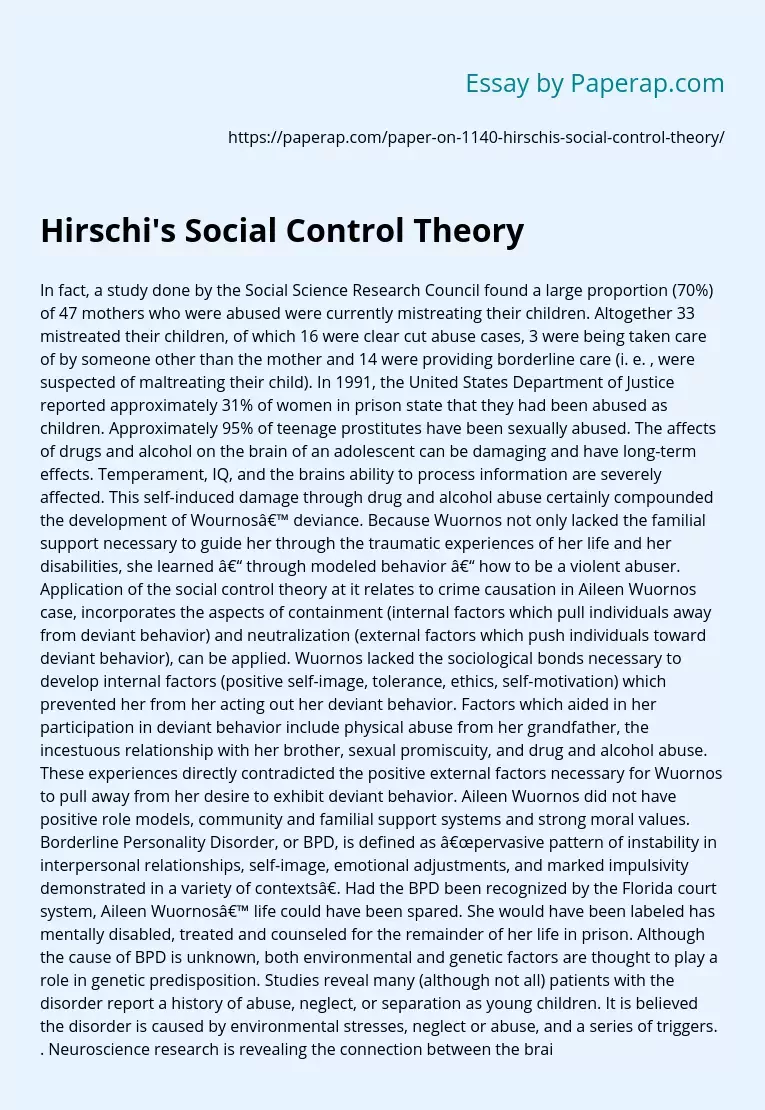Hirschi's Social Control Theory
The following example essay focuses on Hirschi’s theory of social control. Read the introduction, body and conclusion of the essay, scroll down.
In fact, a study done by the Social Science Research Council found a large proportion (70%) of 47 mothers who were abused were currently mistreating their children. Altogether 33 mistreated their children, of which 16 were clear cut abuse cases, 3 were being taken care of by someone other than the mother and 14 were providing borderline care (i. e. , were suspected of maltreating their child).
In 1991, the United States Department of Justice reported approximately 31% of women in prison state that they had been abused as children.
Approximately 95% of teenage prostitutes have been sexually abused. The affects of drugs and alcohol on the brain of an adolescent can be damaging and have long-term effects. Temperament, IQ, and the brains ability to process information are severely affected. This self-induced damage through drug and alcohol abuse certainly compounded the development of Wournos’ deviance. Because Wuornos not only lacked the familial support necessary to guide her through the traumatic experiences of her life and her disabilities, she learned – through modeled behavior – how to be a violent abuser.
Application of the social control theory at it relates to crime causation in Aileen Wuornos case, incorporates the aspects of containment (internal factors which pull individuals away from deviant behavior) and neutralization (external factors which push individuals toward deviant behavior), can be applied. Wuornos lacked the sociological bonds necessary to develop internal factors (positive self-image, tolerance, ethics, self-motivation) which prevented her from her acting out her deviant behavior.
Factors which aided in her participation in deviant behavior include physical abuse from her grandfather, the incestuous relationship with her brother, sexual promiscuity, and drug and alcohol abuse. These experiences directly contradicted the positive external factors necessary for Wuornos to pull away from her desire to exhibit deviant behavior. Aileen Wuornos did not have positive role models, community and familial support systems and strong moral values.
Borderline Personality Disorder, or BPD, is defined as “pervasive pattern of instability in interpersonal relationships, self-image, emotional adjustments, and marked impulsivity demonstrated in a variety of contexts”. Had the BPD been recognized by the Florida court system, Aileen Wuornos’ life could have been spared. She would have been labeled has mentally disabled, treated and counseled for the remainder of her life in prison. Although the cause of BPD is unknown, both environmental and genetic factors are thought to play a role in genetic predisposition.
Studies reveal many (although not all) patients with the disorder report a history of abuse, neglect, or separation as young children. It is believed the disorder is caused by environmental stresses, neglect or abuse, and a series of triggers. . Neuroscience research is revealing the connection between the brain and its link to negative emotion, impulsivity, mood instability, aggression, and anger– all emotions and traits seen in people with BPD. Tests show that people “born” to exhibit spontaneous aggression have impaired brain function and that a small almond-shaped structure deep inside the brain regulates negative emotion.
Under the influence of drugs, alcohol, or stress, studies show this might be more pronounced. Wuornos could have been medicated with serotonin, norepinephrine and acetylcholine to regulate her emotions, including sadness, anger, anxiety, and irritability. These “mood stabilizers” work much like medicines to manage high blood pressure or diabetes. According to Hirschi’s social control theory, Wuornos’ disability put her at a higher risk to become a substance abuser. When the four elements of social bonding (attachment, commitment, involvement and belief) are examined, the depth of neglect Wuornos experienced is clear.
Sexual promiscuity degraded her image, and her incestuous relationship with her brother was common knowledge in her community. These factors would cause her ability to bond with healthy members of her community difficult if not impossible. Wuornos’ lack of self-motivation and self-esteem, as seen in her unwillingness or inability to successfully graduate from high school, her failed marriage, and her failed romantic relationships. She lived her life as though she believed she was useless and had nothing to lose. And lived her life as though she felt detached from the society in which she lived.
The feelings of detachment would make her vulnerable to engage in illicit drug use and alcohol over-consumption. The element of involvement centers around the idle time Wuornos spent when she was not involved with some person or activity. As an uneducated, mentally disabled person already engaging in deviant behavior through prostitution, Aileen’s “idle time” was spent engaging in deviant behavior by drinking and using drugs. She did not practice convention in any aspect of her life, so the boundaries between her structured and idle lives were non-existent.
Belief, or belief system, for Aileen Wuornos certainly did not exist by the time she was tried and imprisoned. However, the belief system (values and norms) of those around her who recognized she was disturbed were probably relaxed out of guilt, pity, or fear. The incidents which involved Wuornos attempting to stab her siblings without being removed from the home or counseled extensively is evidence of the lack of consistent standards which would have been necessary to curb Wuornos’ deviant behavior or prevent it from escalating to serial murderer later in life.
Instead, concessions in the values and norms of those around Wuornos’ enabled her to continue to behave violently, run away, and return to start the cycle again. As the facts in this essay reveal, the life history of Aileen Carol Wuornos constituted a genetic predisposition to have a penchant for deviant behavior, however, her many years of neglect, abuse, untreated illness and lack of positive social relationships it was sealed her fate and pushed her to become a deviant serial killer.
Her neglected mental health, drug abuse and progressed her social failures. Aileen Carol Wuornos was 46 on the day of her execution.
Hirschi's Social Control Theory. (2017, May 23). Retrieved from https://paperap.com/paper-on-1140-hirschis-social-control-theory/

